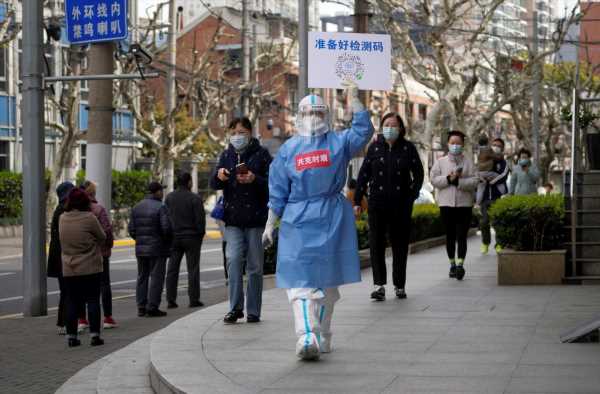Beijing city on Monday held the first round of three-time COVID-19 mass testing of over 3.5 million people in one of its high-profile districts following a spike in cases, raising fears that the Chinese capital could face a similar situation to the eastern metropolis Shanghai, which has seen some 25 million people shut in their homes for weeks.
Beijing’s local government has ordered Chaoyang district hosting most of the diplomatic missions as well as the seat of top leadership and home to some 3.5 million residents, to have three rounds of mass nucleic acid testing starting on Monday after the district registered most COVID-19 cases in the capital’s latest epidemic surge triggered by the Omicron variant, official media reported.
Throughout the day the district witnessed long lines of people at a host of places undergoing nucleic acid tests. The second round of tests will be held on Wednesday and Friday after which the city officials may decide whether a Shanghai-style lockdown was needed to curb the transmission.
Beijing’s health officials on Monday announced 29 fresh cases taking the total cases to 70 in the city.
Chaoyang district reported 49 cases so far in the last few days.
Meanwhile, fear gripped the city of over 21.5 million people as people resorted to panic buying apprehending the ongoing Shanghai-style lockdown which resulted in severe food shortages leading to protests by people who were confined to their flats.
Stocks of vegetables, rice, oil, noodles and other daily necessities disappeared from shelves of almost all the supermarkets while online food stores stopped supplying after running out of stocks.
On Tuesday, Shanghai, where Omicron cases continue to spiral, completed its fourth week in lockdown.
Asked about what steps the Chinese government is taking to address public concerns, especially that of thousands of foreigners in Beijing, Chinese Foreign Ministry spokesman Wang Wenbin put up a staunch defence of China’s much-criticised Zero case policy.
“China’s dynamic zero-COVID policy and epidemic-prevention protocol are based on science and experts’ opinions,” Wang told a media briefing.
The measures are in keeping with China’s realities and World Health Organisation’s guiding principles and have effectively guaranteed the safety and health of Chinese and foreign citizens living in China, and made an important contribution to the global fight against the COVID-19 pandemic,” he said.
Wang said, “According to relevant data, China’s COVID-19 fatality rate was 0.6 for every 100,000 in 2021, only 1/606 of that of the US, giving China one of the lowest fatality rates from COVID-19 in the world.”
“We also want to point out that every epidemic protocol has its costs. The prevention and control measures in some Chinese cities have had some impact on production and daily life, as could happen in any country. But what makes China different from other countries is that the vast majority of the Chinese people understand and support the Chinese government,” he said.
“China did not lie flat over the Delta variant. We have resolutely fought against the virus. Now in the face of the Omicron variant, China will not lie flat, either. We are resolutely fighting the virus. We will win the battle and make greater contributions to the world,” he said.
According to China’s National Health Commission report released on Monday, Beijing reported 14 cases on Sunday of which 11 of them were in Chaoyang district which is the central part of the city where the top Chinese leadership resides.
The Chinese mainland on Sunday reported over 20,190 cases, the majority of them being asymptomatic cases.
Shanghai, a vast city of 26 million people, has reported 2,472 positive cases and 16,983 asymptomatic cases.
On Sunday, the city’s COVID-19 death toll crossed 100 in the current outbreak.
The city reported 51 deaths on Sunday, the highest in a single day, taking the toll to 138.
With this, China’s overall death toll due to coronavirus, ever since it first emerged in the central city of Wuhan in December 2019 rose to 4,776.
Apart from Shanghai, 17 other provincial-level regions on the mainland saw new local COVID-19 cases, including 79 in Jilin, 26 in Heilongjiang, 49 in Beijing and 29,178 confirmed COVID-19 cases undergoing treatment in hospitals across the country.
Source: Read Full Article

